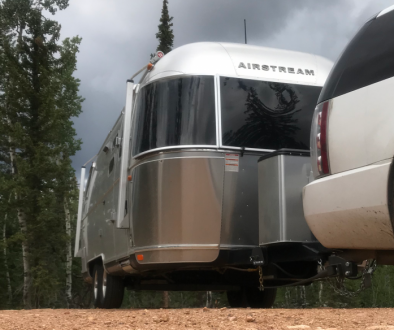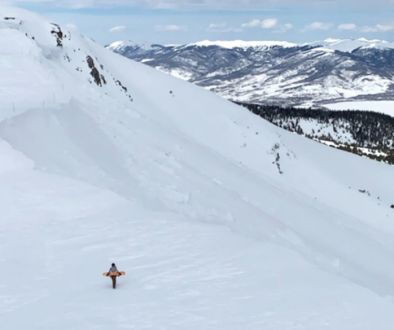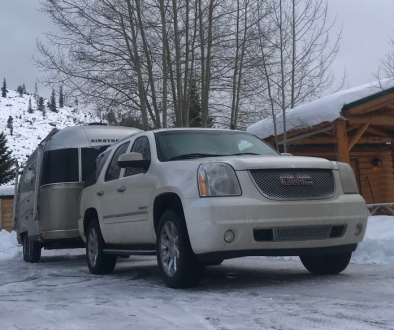What You Need to Know Before Buying an Airstream
Alright, y’all, here’s the deal. The nomadic Airstream life carries with it this connotation of a more simpler existence, which is true on many levels. Downsizing everything I owned was, hands down, one of the most liberating experiences of my life (gawd, we really do have way too much shit). But, there were a lot of things that, one, I didn’t even think about until a couple weeks before moving out of my place, and two, I didn’t realize would be as complicated as they are in real life.
With anything, the ideas we have in our heads are often more glamorous than the day-to-day execution of said ideas, so I wasn’t surprised to be hurdling some of these speed bumps. But, I’d be lying if I said the learning curve isn’t a smidge larger than what I had hoped it would be when embarking on this adventure.
Here’s what you need to know before buying an Airstream.
Establishing a Domicile
Yeah, I don’t use that word in regular speech either. Basically, you need to have a permanent residence. Somewhere. Since I own a house in Boise, I can conveniently claim that this is my permanent residence. My car and Airstream are both registered to this address. I will file my taxes from this address. My driver’s license is from Idaho. Blah. Blah. If you don’t have property, then there are three states that make great domiciles: Texas, South Dakota, and Florida. I’m not going to go into full detail on why, but they are the most RV friendly, and you can use a service like Escapees to get set up.
I think this is fairly obvious, but getting mail in a mobile home is not exactly, well, possible. And, I don’t really have the luxury of pawning my mail off on a beloved family member. Okay, that’s kind of a lie. My mom has a mailbox in Denver that I forwarded my mail to for the time being, but she doesn’t have much of a permanent residence in Denver, so I don’t know how long this plan will work. With that being said, I’ve learned that there are services that will accept your mail for you and disperse it to you as requested or (even better) will send you electronic PDFs (with your permission). You can set yourself up through MyRVmail. Take advantage of the companies who allow you to go paperless. The real MVP here is Amazon Prime and Whole Foods – if you know me then you know that I have a strong to quite strong obsession with Whole Foods anyway – but you can now ship Amazon packages to Whole Foods for pick-up in one of those cute yellow lockers. Swoon.
WiFi
Ooph. Internet access may be my biggest priority in all of life. If you don’t know, I am a brand strategist and creative director at my own company, Sleigh. I work remotely for all of my clients, which gives me the freedom to choose this Airstream life, but it also means that I live and die by WiFi. I’m not going to go into a ton of detail about all of the options because, honestly, there are so many, but I opted to buy the unlimited data plan from my cell phone carrier (AT&T). If I notice a lot of bottlenecking once I reach a certain threshold, I will cross that bridge when I come to it. I usually go spend a few hours on public WiFi during the day (yes, at Whole Foods) and then I use my hotspot for a few hours at night. I have yet to really venture into more remote areas where service is spotty, so to date, smoothing sailing. To learn more about all the options, you can check out this comprehensive guide here. Unfortunately, there are so many options because nothing really stands out as being exemplary.
Laundry
First of all, one of my biggest struggles in the Airstream was deciding where to put my dirty clothes. I workout everyday, and yes, I sweat, so I don’t really have the luxury of wearing those articles of clothing multiple times before a wash (like I do with all of my regular clothes). I finally opted for a college dorm room chintzy hamper underneath the dining room table at the front of my trailer. Could it get smelly? Yes. Only time will tell. And, when it comes to actually doing laundry, most RV campgrounds have washers and dryers. If not, you best get those laundromats on Google (or have a nice friend who likes sharing with you).
Tow Vehicle
Thank gawd for car backup cameras is all I have to say. I literally do not understand how anyone could hitch up a trailer to a car without one. I’m currently towing my 23’ Airstream International with a 2008 GMC Yukon Denali (yes, it has a backup camera). When I started looking into buying an Airstream a year ago, I learned quickly that my Ford Edge was not going to cut it (bless her soul). I was obsessed with getting a Yukon, but (in true Stephanie fashion) I was very particular about the one that I wanted. It had to be white with tan leather interior. I wanted a backup camera, and it had to have no more than 100k miles.
I found one. In Kansas. So, if you have been following me through Instagram for the last year, you will know that I flew to Jayhawk country, picked up my new whip, stopped at Whole Foods (obvi), and then drove 18 hours back to Idaho, sleeping at some random rest stop in Colorado for about three hours. But, honestly, I love my car. I’ve put 20k miles on her in the last year, and the only time I can really feel any weight when towing is going over the high-elevation mountain passes. She’s a damn champ.
Sidebar. I highly recommend purchasing an extended warranty. I paid about $2k for a 5-year or 60k mile warranty, and I’ve saved in the ballpark of $3k to date (thanks for the advice, Dad).
Update. I ended up trading in my 2008 Yukon Denali about halfway through my first year on the road. I bought a 2015 Ford F-150. And I hated it. Not because there was anything wrong with the truck itself. I just found that I posted up in places way too long and absolutely hated having a truck as my everyday driver. On my voyage back to Colorado from Texas, which you can read about here, I ended up trading in my new rig for old faithful – well, old faithful 2.0 – and I couldn’t be happier.
Storage
While I sold and gave away a lot of stuff (eBay queen over here), it goes without saying that I felt attached to certain material items that would not be feasible to bring on an Airstream or in my trunk (like my Kitchen-aid Mixer or big screen TV). Again, I am fortunate in this area because I do have a house with a decent-sized closet where I was able to put items that I will one day want to use when I return.
Mind you, I have absolutely zero plan when it comes to the length of time that I will spend on the road (it ended up being a year, and you can read my synopsis here). I could give two shits about any of it by the time I get back (update: it felt a lot like Christmas opening up old boxes of clothes, and it was nice not having to go out and purchase professional attire).
But if you don’t have access to your own mini storage closet, then you are forced to purchase one and pay a monthly fee or pawn space in a friend or family member’s garage. My biggest concern was whether or not to take all my winter gear in my car when setting out on the road in the middle of summer. I’m a huge snowboard buff, and a big reason I bought the Airstream was to chase powder all winter, so it made sense for me to put all of my snowboard gear in boxes and keep them in my trunk. Whether or not this is my smartest idea will be determined at a later date.
Finding a Parking Spot
My final point, and probably the most important, is finding a place to park the Airstream. Hands down, the biggest misconception about this relatively nomadic lifestyle is that I can pull up anytime, anywhere with a few dollar bills in my pocket and zero plan. I am quickly learning that to be nomadic requires an intense amount of preparation. When I arrived in Denver in my first week with the Airstream in tow, I spent hours calling every state park and RV campground. I am not over-exaggerating when I tell you that there was not a single campsite to be found. Fortunately, my brother and his girlfriend live in Denver and let me Uncle Eddy outside of their house for the week (because it is illegal to sleep in your car or trailer on city streets or in city parking lots).
But the spontaneity of this lifestyle is encumbered by the fact that RV life is becoming increasingly more popular and there really are very limited spaces to go around. Fortunately, technology provides resources like the RV Parky app that allows users to look up campsites in a specific zip code or user location, and the Reserve America website is very detailed with campsite availabilities. But, there is very little opportunity to simply show up somewhere and hope that it works out (at least not in the prime camping months of summer). Plus, campsites or RV spots are usually sold by the night or the month; at the two-week mark, a month generally becomes cheaper than paying nightly. To be savvy, one must really calculate how long to stay at a given location before moving on to the next destination.
These hurdles most certainly don’t create any air of impossibility. But, they definitely remove adverbs like “easy” from being used to describe this lifestyle. Granted, if it were easy, everyone would do it. I didn’t sign up for easy. In fact, quite the contrary.
I know that the more I experience, the more I will grow, and I’m just not content with settling.



